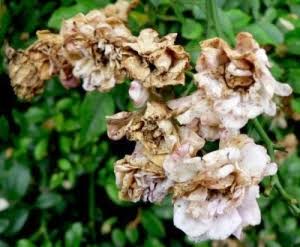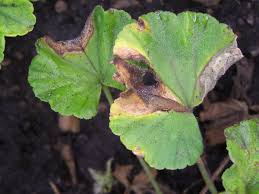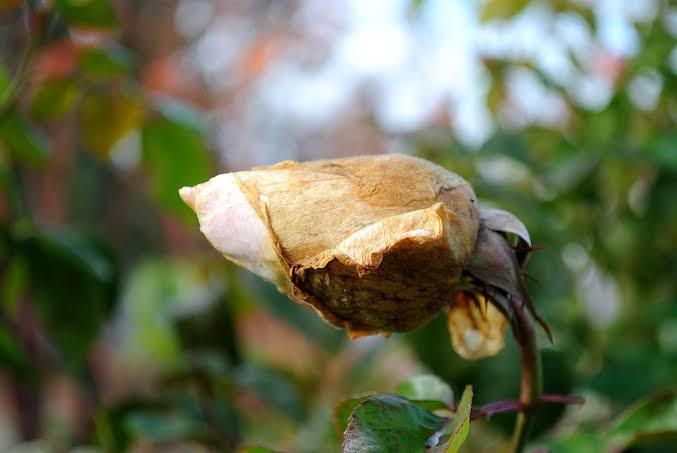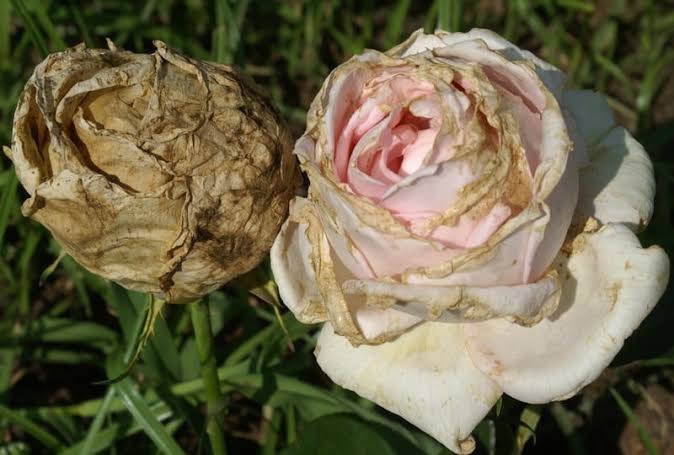Botrytis blight, scientifically known as Botrytis cinerea, is a plant disease that affects a variety of crops, causing significant economic losses in agriculture. This fungal pathogen is commonly referred to as gray mold due to the characteristic grayish-brown spore masses it produces on infected plants.
Botrytis blight is a major concern for farmers worldwide, affecting a wide range of host plants, including fruits, vegetables, ornamental flowers, and even some field crops. The fungus is particularly adept at exploiting weakened or injured plant tissues, making it a formidable adversary for growers.
The life cycle of Botrytis cinerea begins with the germination of spores on plant surfaces, especially in humid conditions. Once germinated, the fungus produces mycelium that penetrates plant tissues, leading to the development of visible symptoms. These symptoms often include wilting, browning, and the formation of a fuzzy gray mold on infected plant parts.
One of the distinctive features of Botrytis blight is its ability to infect both living and dead plant tissues. This versatility allows the fungus to persist in the environment, making it challenging to manage. Additionally, the pathogen can produce a variety of enzymes and toxins that contribute to its pathogenicity, aiding its colonization of host plants.
Cultural practices such as proper spacing, pruning, and adequate ventilation can help reduce the risk of Botrytis blight. Furthermore, the use of fungicides is a common strategy employed by farmers to manage and control the spread of the disease. However, continuous monitoring and integrated pest management strategies are crucial for effective control, as the fungus can develop resistance to chemical treatments over time.
Botrytis blight outbreaks are often exacerbated by environmental conditions favoring fungal growth, such as high humidity and moderate temperatures. Therefore, understanding the local climate and implementing preventive measures during periods conducive to disease development is essential for minimizing crop damage.
Botrytis blight, caused by the fungus Botrytis cinerea, poses a significant threat to a wide range of crops. Its ability to infect various plant species, coupled with environmental adaptability, makes it a challenging foe for agricultural practitioners. Effective management requires a combination of cultural practices, chemical control, and vigilance to mitigate the impact of this pervasive gray mold on crop yields.
Read Also: Powdery Mildew: Description, Damages Caused, Control and Preventive Measures
Plants Affected by Botrytis Blight

Botrytis blight, caused by the fungus Botrytis cinerea, can affect a diverse range of plants. This includes fruits, vegetables, ornamental flowers, and even some field crops. Some notable examples of plants commonly affected by Botrytis blight include:
1. Strawberries: Botrytis cinerea is a common problem in strawberry crops, causing gray mold on the berries. Infected strawberries often develop a soft, mushy texture and may become covered with a grayish-brown mold.
2. Grapes: In vineyards, Botrytis blight can lead to the development of noble rot, affecting wine grapes. While noble rot is desirable in certain winemaking processes, excessive infection can still lead to economic losses.
3. Tomatoes: Botrytis cinerea can infect tomatoes, particularly during periods of high humidity. Infected tomatoes may show signs of decay, and a characteristic gray mold can develop on the affected areas.
4. Roses: Ornamental flowers like roses are susceptible to Botrytis blight. The fungus can cause wilting, browning of petals, and the formation of gray mold on the flowers.
5. Lettuce and Other Leafy Greens: Leafy greens, including lettuce, can be affected by Botrytis blight. The fungus may cause browning and decay of leaves, making the affected produce unmarketable.
6. Beans: Certain varieties of beans, especially those grown in humid conditions, can be vulnerable to Botrytis blight. The fungus can lead to the development of gray mold on the pods.
7. Chrysanthemums: Ornamental plants like chrysanthemums are also at risk. Botrytis blight can cause flower buds to turn brown, and a fuzzy gray mold may develop on the infected parts.
8. Sunflowers: Botrytis cinerea can affect sunflowers, leading to the formation of gray mold on the flower heads. This can impact both ornamental and oilseed sunflower varieties.
These examples highlight the broad host range of Botrytis blight, emphasizing the importance of vigilance and effective disease management strategies across various crops and plant species.
Damages Caused by Botrytis Blight (gray mold)

Botrytis blight, commonly known as gray mold, inflicts various damages on affected plants, leading to economic losses for farmers. The damages caused by Botrytis blight include:
1. Crop Yield Reduction: One of the primary impacts of Botrytis blight is a decrease in crop yield. The fungus attacks different plant parts, such as fruits, flowers, and stems, causing them to decay and reducing the overall harvestable quantity.
2. Quality Deterioration: The quality of affected crops is significantly compromised. Fruits and vegetables infected by Botrytis blight often develop a soft, mushy texture, making them unappealing and unsuitable for sale or consumption. This can lead to financial losses for growers, especially in high-value crops.
3. Post-Harvest Losses: Botrytis cinerea can continue to develop on harvested produce, contributing to post-harvest losses. This is particularly problematic for crops like strawberries, grapes, and tomatoes, where the fungus can thrive even after the fruits have been picked.
4. Reduced Marketability: The appearance of gray mold on plants diminishes their market value. Consumers are less likely to purchase fruits, vegetables, or flowers that show signs of Botrytis infection. This can impact the marketability of the produce and result in lower profits for farmers.
5. Noble Rot in Grapes: While noble rot caused by Botrytis cinerea can be desirable in certain winemaking processes, excessive infection can still lead to reduced grape quality and quantity. Balancing the positive effects of noble rot with its potential negative impacts becomes crucial for vineyard management.
6. Affects Ornamental Plants: Botrytis blight can damage ornamental plants, such as roses and chrysanthemums. The aesthetic appeal of these flowers is compromised as petals turn brown, and the presence of gray mold makes them less desirable for landscaping or decorative purposes.
7. Weakened Plant Health: Prolonged exposure to Botrytis blight can weaken the overall health of plants. The fungus can exploit weakened or injured tissues, making plants more susceptible to other diseases and environmental stresses.
8. Challenges in Storage: For crops that are intended for storage, such as onions and potatoes, Botrytis blight can pose challenges. The fungus can contribute to storage rot, leading to additional losses during the storage period.
However, Botrytis blight causes a range of damages, impacting both the quantity and quality of crops. The economic consequences for farmers are significant, making effective disease management strategies crucial for minimizing losses associated with this pervasive fungal pathogen.
Read Also: Downy Mildew: Description, Damages Caused, Control and Preventive Measures
Control and Preventive Measures

Controlling and preventing Botrytis blight (gray mold) requires a combination of cultural, biological, and chemical measures. Here are some effective strategies:
1. Proper Plant Spacing and Pruning: Ensure adequate spacing between plants to promote good air circulation. Pruning to remove excess foliage can also help reduce humidity levels around the plants, creating an environment less favorable for Botrytis cinerea.
2. Good Drainage: Improve soil drainage to prevent waterlogged conditions, as excessive moisture enhances the development and spread of Botrytis blight. Use well-draining soil and avoid over-irrigation.
3. Avoid Overhead Irrigation: Minimize the use of overhead irrigation systems, as wet foliage provides an ideal environment for the fungus to thrive. Instead, use drip irrigation or apply water directly to the base of plants.
4. Timely Harvesting: Harvest fruits and vegetables at the appropriate maturity stage. Delayed harvesting can increase the likelihood of Botrytis infection, especially in crops like strawberries and grapes.
5. Remove Infected Plant Material: Promptly remove and destroy any plant material showing signs of Botrytis blight. This includes infected leaves, flowers, or fruits. Proper disposal prevents the spread of spores and reduces the inoculum in the environment.
6. Biological Controls: Consider using biological control agents, such as beneficial fungi (like Trichoderma) or bacteria, to suppress the growth of Botrytis cinerea. These agents can be applied preventively to protect plants from infection.
7. Fungicide Applications: In situations where the risk of Botrytis blight is high, fungicides can be used. Copper-based fungicides and synthetic fungicides with Botrytis activity can be applied according to recommended guidelines. Rotate fungicides with different modes of action to reduce the risk of resistance development.
8. Temperature and Humidity Management: Maintain environmental conditions that discourage Botrytis growth. Proper temperature and humidity control in storage facilities for crops like onions and potatoes can help prevent post-harvest losses.
9. Integrated Pest Management (IPM): Implement an integrated pest management approach that combines multiple control strategies. This includes regular monitoring for disease symptoms, employing cultural practices, and using chemical interventions judiciously.
10. Resistant Varieties: Choose plant varieties that show resistance or tolerance to Botrytis blight when available. Resistant varieties can be an effective component of an integrated disease management plan.
11. Quarantine Measures: If possible, quarantine new plant material to prevent the introduction of Botrytis cinerea. This is especially important for nurseries and areas where new plants are introduced regularly.
Implementing a comprehensive and integrated approach that combines these measures is essential for effective control and prevention of Botrytis blight. Regular monitoring and adaptation of strategies based on the specific conditions of the crop and environment are key components of successful disease management.
Frequently Asked Questions (FAQs) About Botrytis Blight (Botrytis cinerea)
1. Q: What is Botrytis blight, and what causes it?
A: Botrytis blight, also known as gray mold, is a plant disease caused by the fungus Botrytis cinerea. It affects various crops, leading to decay and a characteristic grayish-brown mold on infected plant parts.
2. Q: Which plants are commonly affected by Botrytis blight?
A: Botrytis blight can affect a wide range of plants, including fruits (strawberries, grapes), vegetables (tomatoes, beans), ornamental flowers (roses, chrysanthemums), and certain field crops.
3. Q: How does Botrytis cinerea spread?
A: The fungus spreads through airborne spores produced on infected plant material. It can also be transmitted through water splashes and contaminated tools or equipment.
4. Q: What are the symptoms of Botrytis blight?
A: Symptoms include wilting, browning, and the development of a fuzzy gray mold on affected plant parts. Fruits and flowers may become soft and mushy.
5. Q: Can Botrytis blight affect stored produce?
A: Yes, Botrytis blight can contribute to storage rot in crops like onions and potatoes. Proper storage conditions and monitoring are essential to minimize post-harvest losses.
6. Q: How can I prevent Botrytis blight in my garden?
A: Practices such as proper plant spacing, good drainage, avoiding overhead irrigation, and timely harvesting can help prevent Botrytis blight. Regularly removing infected plant material is also crucial.
7. Q: Are there natural ways to control Botrytis blight?
A: Yes, biological controls using beneficial fungi (e.g., Trichoderma) or bacteria can be effective. Additionally, maintaining proper temperature and humidity levels and selecting resistant plant varieties are natural approaches.
8. Q: Can fungicides be used to control Botrytis blight?
A: Yes, fungicides, including copper-based products and synthetic fungicides with Botrytis activity, can be used. It’s important to follow recommended guidelines and consider integrated pest management practices.
9. Q: Is Botrytis blight harmful to humans or animals?
A: Botrytis cinerea primarily affects plants and is not known to be harmful to humans or animals. However, consumption of infected produce may result in quality issues and is generally not recommended.
10. Q: Can Botrytis blight be completely eradicated from a field or garden?
A: Complete eradication may be challenging, but effective management practices can significantly reduce the impact of Botrytis blight. Integrated strategies, including sanitation and proper disease monitoring, are key components.
Read Also: Everything You Need to Know About Moen Garbage Disposal

